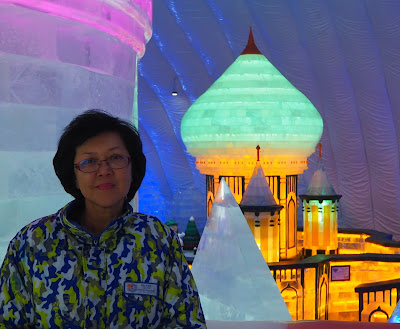One of the most frustrating aspects of traveling with group tours is the rigid, pre-planned itinerary that leaves little room for spontaneity or change. Even worse, some stops are allocated such absurdly short durations that you barely have time to do anything - sometimes just enough for a quick toilet break.
A prime example of this was our stop at the Saint Sophia Cathedral in Harbin. We were given a mere 10 minutes. What can one realistically do in 10 minutes? At best, snap a few photos from a distance. There was certainly no chance to step inside, let alone take a leisurely stroll to appreciate the cathedral's stunning interior and architecture. It felt more like a box-ticking exercise than a meaningful visit.
**************************************************
St. Sophia Cathedral was originally built in 1907 to serve the many Russians who had settled in the region following the Russo-Japanese War of 1904-1905. The original structure was made of timber. Between late 1923 and late 1932, the cathedral underwent significant expansion and renovation. The result was an architectural masterpiece - widely hailed as a monumental work of art and recognized as the largest Orthodox Church in the Far East.
After the founding of the People's Republic of China in 1949, treaties between the Communist Chinese government and the Soviet Union facilitated the transfer of all Russian Orthodox churches to Chinese control. The Chinese government subsequently ended all Christian missionary activity, and St. Sophia Cathedral was closed during two major political movements: the Great Leap Forward (1956–1961) and the Cultural Revolution (1966–1976).
Remarkably, the cathedral's solid structure withstood the ideological and physical destruction of the Cultural Revolution. During this period, it was repurposed as a warehouse for a state-run department store. Its windows were bricked up, and tall concrete walls were erected on all four sides, rendering the once-iconic cathedral both inaccessible and invisible from the street. Over the years, additional buildings - an auto shop, a pen factory, and residential apartments - further obscured it from public view.
The cathedral's fortunes began to change in 1996, when the Chinese central government designated it a national cultural heritage site as part of a broader campaign to protect historical landmarks. In response, local businesses, enterprises, and individuals from the surrounding area collectively donated US$1.5 million to fund its restoration. All surrounding structures that obstructed the cathedral were demolished, and in 1997, St. Sophia's magnificent façade was fully restored.
Today, the cathedral no longer functions as a place of worship. Instead, it has been repurposed as the Harbin Municipal Architecture and Art Museum - a tribute to the city's multicultural history and Russian influence.
As I stood before this once-sacred site, a thought struck me: could China truly evolve as a nation if places like St. Sophia Cathedral were once again allowed to fulfill their original spiritual purpose?

















